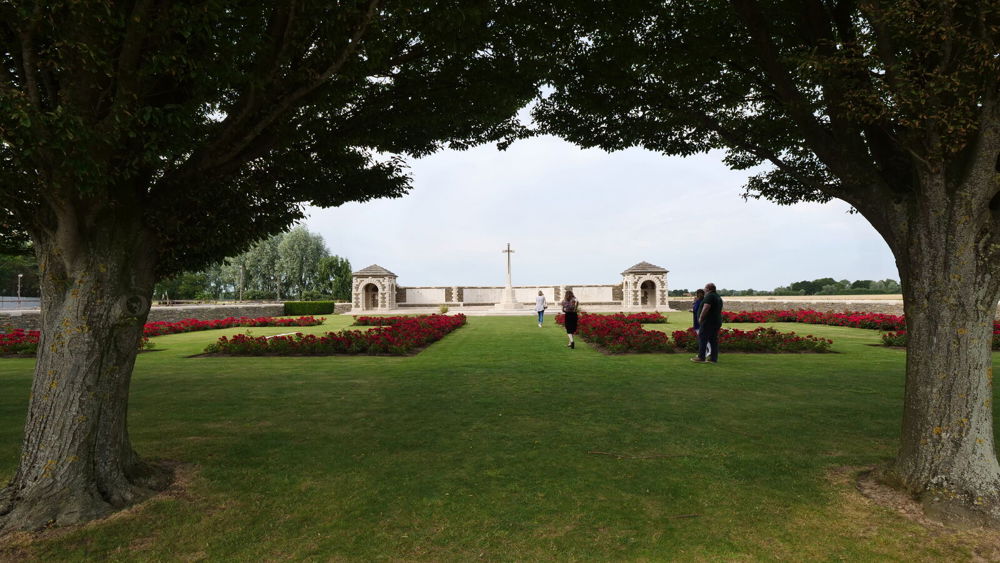17 November 2025
5 Unique & Unusual Cemeteries & Memorials to visit in France & Belgium
The former battlefields of France and Belgium are dotted with Commonwealth War Graves cemeteries and memorials. Here are five that stand out from the rest.
War cemeteries & memorials in France and Belgium
Belgium and France are home to the largest number of our burials and commemorations. Together, over 785,000 men and women, casualties of both World Wars, are commemorated at Commonwealth War Graves sites in both countries.
It’s hard not to be moved or humbled by the sheer number of our French and Belgian sites. Indeed, you’d be hard-pressed to miss them, especially if taking a trip through the Somme or West Flanders and the Ypres Salient.
Seemingly everywhere you go, you’ll be able to pick out a Cross of Sacrifice rising over the fields, our familiar headstones peeking out behind a hedgerow, or a war memorial standing solemnly sentinel over the landscape.
You’re no doubt familiar with names like Thiepval and Tyne Cot, two of our most iconic locations in the world, but France and Belgium offer a wealth of different cemeteries and memorials to explore beyond the more famous sites.
From sites boasting unusual designs to those with lesser-known histories, we share some of the more unique war cemeteries and memorials in France and Belgium.
Zivy Crater, Thelus, France

Vimy Ridge is one of the most storied episodes of the First World War. For Canada, it was a nation-building event; it was here in April 1917 that the Canadians fought together as a single force for the first time.
Utilising massed artillery and clever use of mining and tunnelling, the Canadians stormed Vimy Ridge. The first German line was captured within half an hour; the following day, the Ridge was in Allied hands, thanks predominantly to the skill, determination, and sacrifice of the Canadian Corps.
As with any major Great War offensive, the Battle of Vimy Ridge was not without cost. The attacking Canadians paid dearly, losing over 10,500 men. Over 3,500 were killed.

During the offensive and in the months that followed, Canadian Corps Burial Officers searched for suitable locations to bury the dead. A pair of craters near the village of Thelus, close to Vimy Ridge, held the answer.
Along with Lichfield Crater, Zivy Crater is one of two crater cemeteries containing Canadian burials of the fighting at Vimy. It was created in April 1916, a year before Vimy, when German tunnellers blew a mine underneath British positions, killing one man and injuring four. The site was occupied by British troops shortly after.
On 9 April 1917, the 18th Battalion (Western Ontario) advanced from Zivy on its way to the ridge. Returning to their positions following victory, they buried some of their fallen comrades in the crater.

Following the war, the burial site passed into Commonwealth War Graves’ care. The site was cleaned up, smoothed over and a grass lawn installed. A knapped flint wall was installed, skirting the crater bowl, invoking the ecclesiastical feel of British Victorian churches, despite its protection of fallen Canadian servicemen.
You’ll notice no headstones at Zivy Crater. The crater itself is a mass grave, containing 53 Canadian burials of the Great War. Five of the men resting here are unidentified. Their names are instead inscribed onto memorial name panels built into the boundary wall.
Note the “CB 1” inscription on the cemetery entrance. This dates from Zivy Crater’s earliest use as a burial ground. At the time of the war, groups of graves made by the Canadian military were not named but rather serially lettered and numbered, in this case “CB 1”.

As the years go by, the former First World War battlefields of France and Belgium have regenerated back to their flourishing grassy selves, but the scars remain. The crater cemeteries, like Zivy, remain silent witnesses to the destruction wrought by the World Wars, physical reminders of the damage and loss created by global conflict.
Bedford House Cemetery, Ypres, Belgium

Ever visited a war cemetery with a moat?
Bedford House Cemetery, a little way to the south of Ypres city centre, is one of our largest war cemeteries in Belgium, commemorating over 5,000 First and Second World War servicemen.
It also features one of the more unusual cemetery layouts in the Ypres Salient.

Before WW1 ripped Flanders apart, Bedford House used to be Chateau Rosendal, a grand country manor set among a picturesque estate boasting woodland, lakes, and a moat.
Chateau Rosendal was occupied by Allied forces in the early days of the Battles of Ypres. The grand house and its many outbuildings and grounds were turned into headquarters, medical facilities, and, eventually, burial grounds.
The Chateau was destroyed as fighting raged across the Ypres Salient. At one point, the grounds were hit by 500 gas shells in a single attack, devastating the estate. All that remains is the chateau’s old icehouse, once used as a casualty dressing station.
Bedford House, along with Woodcote House, was one of the names given to the Chateau Rosendal, and so this is where today’s cemetery gets its name.

During the war, the chateau grounds gradually became covered in cemeteries. Five enclosures existed by the Armistice, though burials from two were removed and established as independent cemeteries.
The current cemetery includes Enclosures No.2, 3, 4 and 6. This is what gives the site its unique layout, illustrating the sometimes disordered nature of burials.
For example, some of the plots and headstone rows are slightly more askew. These were often burials made close to busy medical facilities, where the dead were buried expeditiously.

But the defining feature of Bedford House is its moat. Architect Captain Wilfred Clement von Berg incorporated the winding waterway into the wider design, capturing the essence of the original site while also allowing for room for burials.
Jerusalem War Cemetery, Chouain, France

Heading southeast from Bayeux, along the Rue de Tilly, as the Normandy countryside and bountiful farmers’ fields roll by, Jerusalem War Cemetery, Chouain, can be easy to miss.
Tucked behind a tall, thick hedge on a road junction, keep on the lookout for Jerusalem War Cemetery, as this most inconspicuous of war cemeteries is well worth a visit.
Just 48 Second World War servicemen lie forever in this tiny corner of Normandy, including 48 Commonwealth soldiers and one Czech burial.

The cemetery’s diminutive size - it’s one of the smallest purpose-built CWGC sites in France – reflects its location. Jerusalem itself is a tiny hamlet near the village of Chouain, populated mostly by farmers working Normandy’s rich soil.
The cemetery was begun on June 10, 1944, just four days after D-Day, following a clash with a German armoured column on its way to recapture Bayeux.
Over time, the nearby farm buildings were turned into makeshift medical hubs for troops advancing on Tilly-sur-Suelles. In fact, some of those buried at Jerusalem succumbed to their wounds in the very same farm buildings you can see nearby today.

D-Day was one of the biggest, most significant events of the Second World War. However, it can be hard to humanise and connect with the men behind the headstones at some of our larger cemeteries commemorating the Normandy Campaign’s war dead.
What Jerusalem offers is unparalleled intimacy. It encourages visitors to closely read each name and any personal inscriptions, not the ages of those buried here, and contemplate young lives cut tragically short by war.

Notably, the youngest casualty of the Normandy Campaign, Private Jack Banks, is buried at Jerusalem War Cemetery. Jack was born in Darwen, Lancashire, and lied about his age to serve. He was hit by mortar fire in an attack at Hottot, and passed away, aged just 16.
It can be hard to pull out individual moments from the epic story of D-Day, but at Jerusalem War Cemetery, 48 such moments are waiting to be discovered.
Langemark German Military Cemetery, Belgium

In an area smaller than your average football pitch lie 44,000 servicemen of the Great War. The site dwarfs even the largest Commonwealth War Graves Cemetery, Tyne Cot, with over four times the number of servicemen resting peacefully in its plots and graves.
But rather than holding Commonwealth burials, Langemark German Military Cemetery commemorates German war dead of the First World War.
As you may expect, this is not a Commonwealth War Graves Commission site. Instead, it is cared for by our German counterparts at the Volksbund Deutsche Kriegsgräberfürsorge (VDK).
Even so, two British soldiers are buried here: Private A. Carlill of the Loyal North Lancs Regiment, and Private L.H. Lockley of the Seaforth Highlanders. Their names are emblazoned on a plaque near the cemetery entrance.

So, who does Langemark commemorate, and how does it differ from a Commonwealth War Graves cemetery?
The Imperial German Army established a burial ground near the village of Langemark in the early stages of the First World War. Some of the first burials at Langemark stem from the First Battle of Ypres between October and November 1914.
Some 3,000 student volunteers from the 22nd to 27th Reserve Corps are buried here, lost in repeated frontal assaults on experienced British and French troops as the first German attack on Ypres was repulsed.
As the war progressed, the fighting around the village of Langmark intensified, and the cemetery grew from a small group of graves. It has gone through numerous changes and extensions over the years, including the concentration of all unidentified German casualties discovered in the Ypres Salient post-war.

Notably, the names of over 6,000 fallen German soldiers are carved into oak panels which adorn the gatehouse’s Room of Honour. The gatehouse itself is made of pink Weserberg stone and lacks much of the adornment and flourishes you see in CWGC entrances and gatehouses.
Indeed, the overall layout of the cemetery differs from your typical CWGC site. The first thing is the headstones. The grave markers at Langemark often represent mass burials, bearing the names of upwards of two soldiers sharing their final resting places.
In terms of their design, the Langemark grave markers sit low and close to the ground, more plaques than headstones, in stark contrast to the ordered rows of white headstones you see in our cemeteries.
Massed burials are a central feature of Langemark. The central burial plot, “The Comrades' Grave”, contains over 24,000 burials, including German fighter ace Werner Voss. A bronze plaque lists 17,000 names of those buried here, discovered after extensive research.

Langemark takes its design cues from German funerary architecture and cemetery layout practices of the time. A “woodland cemetery”, graves and burial plots are arranged beneath a mix of tree species, including mighty oaks, which sets them apart from nearby CWGC sites.
Our cemeteries were originally designed to invoke the look and feel of English country gardens. Langemark offers a different kind of peace, one hidden by shady boughs and leaves. It’s particularly stunning towards the end of the year when the low autumnal sun illuminates the cemetery with a golden glow, sunlight playing off the vivid fall foliage.
Langemark is well worth a visit to see the contrast in different types of commemoration among the Great War’s belligerents.
V.C. Corner Australian Cemetery and Memorial

If there’s one thing that makes a Commonwealth War Graves cemetery instantly recognisable, it’s our headstones. Uniform in shape with some exceptions, featuring unique typography and the names of each identified casualty, they are one of our most easily distinguishable cemetery features.
But what if one of our sites didn’t contain any grave markers at all?
Welcome to V.C. Corner Australian Cemetery and Memorial, where you may notice something missing. That’s right: no headstones. Why? To find out, we have to travel back to July 1916 and the Battle of Fromelles.

At this time, the Battle of the Somme is raging with no obvious victory in sight for the attacking Allies. To distract German forces, the Allies launched the Battle of Fromelles. Fromelles was the first time the First Australian Imperial Force (AIF) saw action on the Western Front.
It was a complete disaster. Of the 7,080 Allied casualties taken at Fromelles, more than 5,500 came from the 5th Australian Division.
Fromelles is the only Australian action on the Western Front to achieve no success.
V.C. Corner Australian Cemetery and Memorial was established after the Armistice, following the discovery of more than 400 Australian casualties of Fromelles. However, none of the casualties could be identified.
It was decided not to mark individual graves. Rather, two large plots were created, each marked with flower beds and a central concrete cross, to bury the fallen. What you may not know is that this isn’t a mass grave like the Comrades’ Grave at Langmark. Rather, the dead were still buried individually, as per our cemetery plan.

The unknown men buried at V.C. Corner are not forgotten. They are commemorated by name on the Fromelles Australian Memorial, the impressive stone structure towards the back of the cemetery.
Designed by Sir Herbert Baker, the Fromelles Australian Memorial originally held 1,300 Australians killed at Fromelles, but with no known graves.
In 2009, a mass grave was discovered at nearby Pheasent Wood. Through intense research and investigation, our Recovery and Commemorations teams, alongside partners from around the world, were able to identify some 230 Australian soldiers commemorated on the Fromelles Memorial.

With their graves identified, these servicemen’s names were removed from the Fromelles Memorial. Now, it is the point of commemoration for more than 1,100 Australian troops.
Despite the name, no Victoria Cross winners are commemorated at V.C. Corner. It may be the case that this was an ironic nickname the troops gave to their location. No Australian servicemen were awarded Victoria Crosses at Fromelles.
We may never know the truth behind the name, but V.C. Corner Australian Cemetery and Memorial

